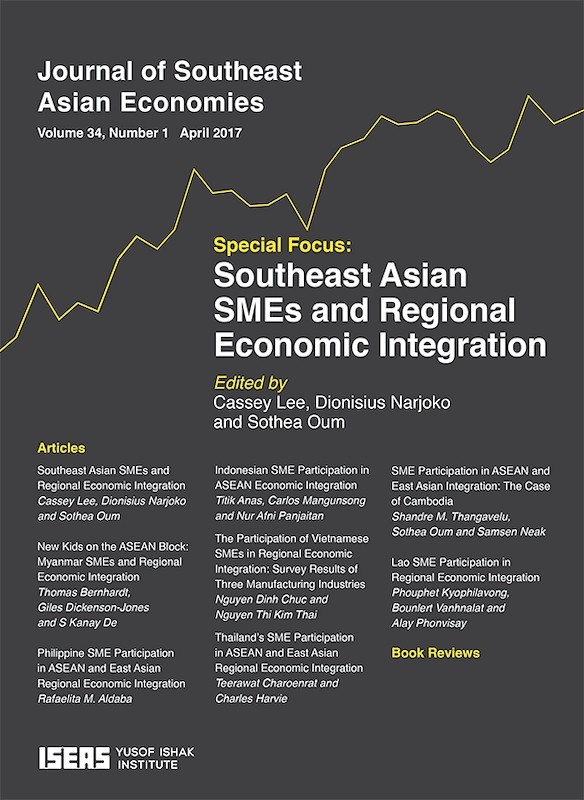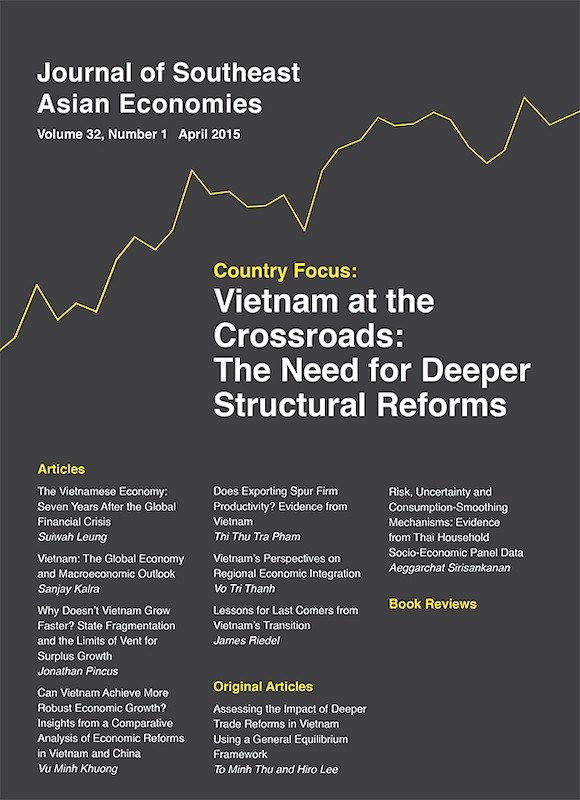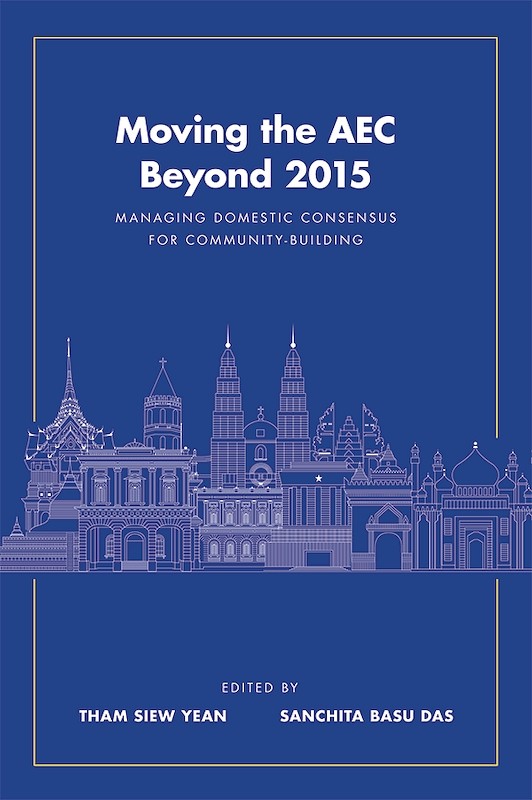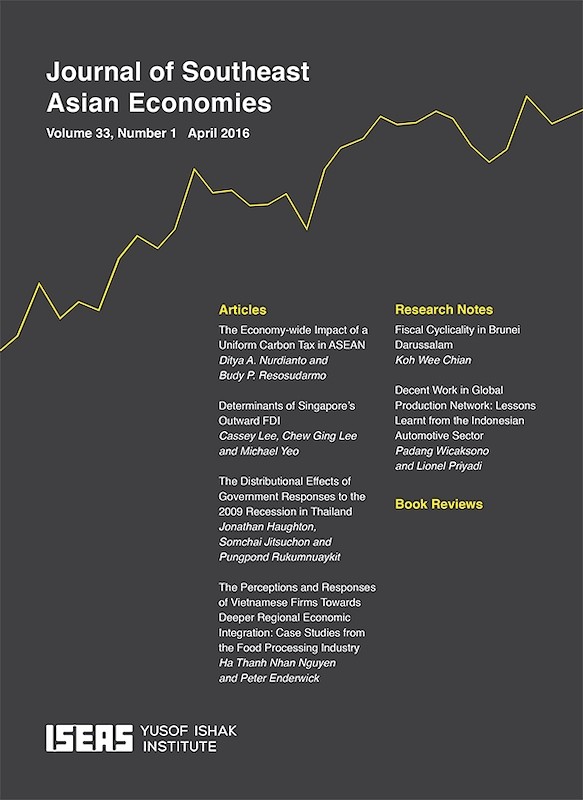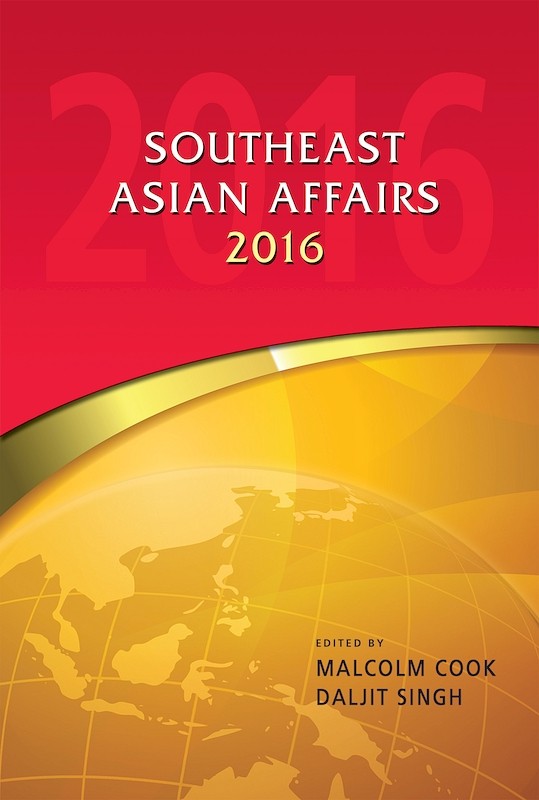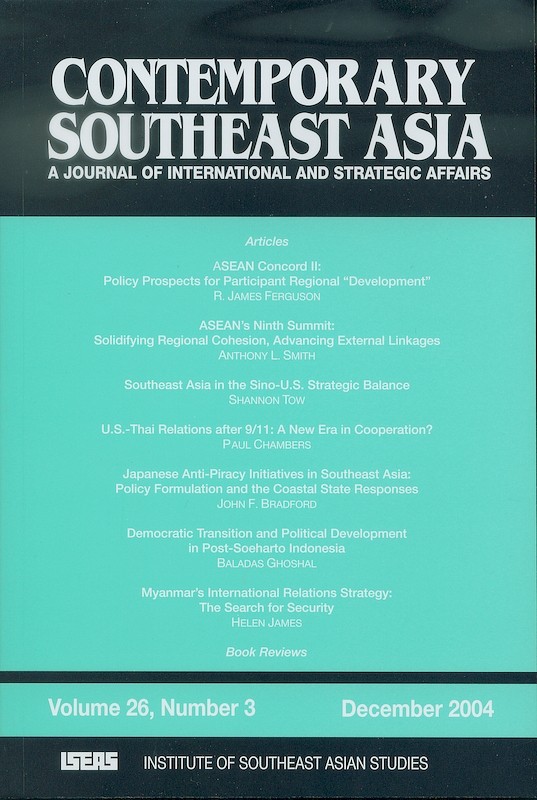Journal of Southeast Asian Economies Vol. 32/2 (Aug 2015). Special focus on "Moving the AEC Beyond 2015: Managing Domestic Consensus for Community-Building
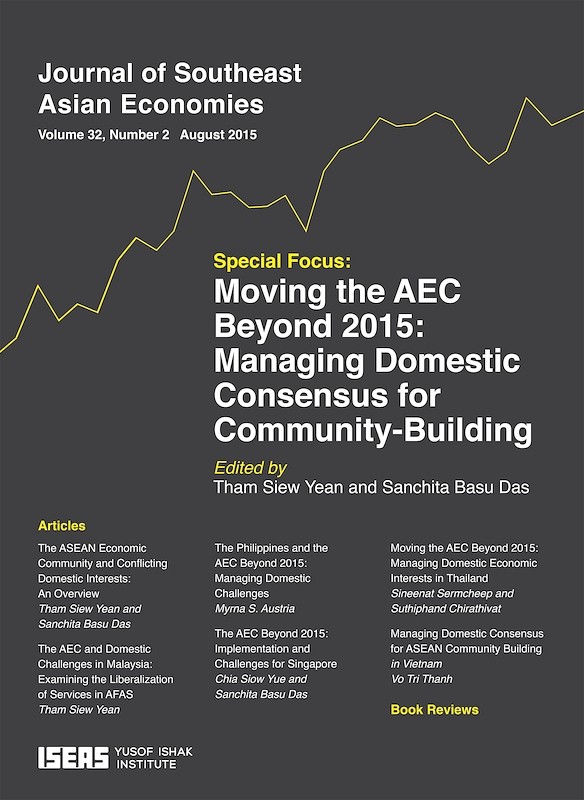
Date of publication:
August 2015
Publisher:
ISEAS – Yusof Ishak Institute
Number of pages:
112
Code:
AE32/2
Contents
-
Journal of Southeast Asian Economies Vol. 32/2 (Aug 2015). Special focus on "Moving the AEC Beyond 2015: Managing Domestic Consensus for Community-Building
[Whole Publication, ISSN: 23395206] -
Preliminary pages
- ARTICLES
-
The ASEAN Economic Community and Conflicting Domestic Interests: An Overview, by Tham Siew Yean, Sanchita Basu Das, authors see abstractThe ten Southeast Asian economies will announce the formation of an ASEAN Economic Community (AEC) on 31 December 2015. The AEC aspires to deliver an integrated market and production base with the free movement of goods, services, capital and skilled labour. However, member economies are still a long way from achieving an integrated production space as they have not yet fulfilled all the stipulated targets set in the 2007 AEC Blueprint. A possible explanation for the current state of economic integration is the presence of conflicting domestic economic interests in member countries. This paper reviews the literature on this issue and synthesizes main observations from selected country studies examining the nature of these conflicting interests. It concludes by providing key policy recommendations for fostering domestic consensus in the respective countries studied in this special issue so that they may support the implementation of
-
The AEC and Domestic Challenges in Malaysia: Examining the Liberalization of Services in AFAS, by Tham Siew Yean, author see abstractAs the end of 2015 draws nearer, the prospect of meeting all the goals of the ASEAN Economic Community (AEC) Blueprint appears dimmer by the day. The literature identifies two prominent gaps in ASEAN’s journey towards an economic community as defined by its own vision. First, the extensive literature on the AEC, and this includes the scorecard designed to monitor the implementation of its goals, suggests that there appears to be a gap between commitments and the achievements of the AEC Blueprint targets. Second, attaining a “free flow of services” as stated in the AEC goals, is also hampered by a gap between commitments in liberalization and actual practice. The objectives of this paper are twofold. First, it seeks to review the gap between commitments and practice in Malaysia. Second, it aims to examine domestic conflicts that may constrain Malaysia’s services liberalization efforts in ASEAN. A key question considered in the analysis is the source or sources of these conflicts. Is the conflict confined to the private sector or is the government conflicted from within in terms of services liberalization? In other words, are there certain policies that may negate or off-set liberalization efforts? The key finding in this paper shows conflicting objectives in government policies to be the main reason for the slow pace of liberalization thus far.
-
The Philippines and the AEC Beyond 2015: Managing Domestic Challenges, by Myrna S Austria, author see abstractAs the deadline for the ASEAN Economic Community (AEC) approaches, the Philippines has yet to complete the implementation of its commitments in the AEC Blueprint. While it is true that the government has implemented most of them, these policy reforms have yet to make an impact on the economy. This paper examines the country’s performance in terms of its commitments in the AEC by identifying the gaps between those commitments and actual implementation. It also examines the domestic economic conflicts that have hampered Philippine policy reform efforts, focusing on the automobile industry. The conflicts may be due to a lack of common economic interests among firms in the industry as well as because of the lack of coherence of domestic policies that have limited, if not negated, progress towards economic integration. Domestic conflicts have created an industry that has failed to develop as a major exporter as well as a source of employment and income for the country.
-
The AEC Beyond 2015: Implementation and Challenges for Singapore, by Chia Siow Yue , Sanchita Basu Das, authors see abstractThis paper discusses Singapore’s progress in implementing the ASEAN Economic Community (AEC) and tries to explore whether the city-state has encountered any domestic conflict whilst doing so. It concludes that being a highly trade- and FDI-dependent economy, it is in Singapore’s national interest to be a part of the AEC. It is one of the leading ASEAN countries to implement the AEC initiatives. When examining domestic conflicts, Singapore presents a unique case as the city-state has long been exposed to the competitive forces of globalization, well before the development of the AEC. The country adopts non-protectionist measures to manage competitive pressures from the global economy. Almost full employment and a low incidence of poverty also minimize the negative impacts of liberalization. Case studies of the electronics and aviation sectors highlight how these two sectors are adjusting to liberalization and competition from the global economy, including the AEC. With respect to the electronics sector, which is an integral part of regional production networks, Singapore is continually progressing up the value chain. In the case of the aviation sector, the city-state continues to meet global and regional challenges through cooperative arrangements with the aviation industries of other countries and by upgrading and expanding its air services.
-
Moving the AEC Beyond 2015: Managing Domestic Economic Interests in Thailand, by Sineenat Sermcheep, Suthiphand Chirathivat, authors see abstractThe ASEAN Economic Community (AEC) is Thailand’s current priority and the AEC Blueprint is being progressively implemented in the country. However, different domestic economic interests have contributed to the slow pace of implementation. Three case studies — the agricultural sector, the logistics industry, and the mobility of medical professionals — are used to illustrate this. To move the AEC beyond 2015 and to enhance consensus-building during the community-building process, this paper puts forth the following policy recommendations: (i) the Thai government should enhance awareness of the community-building process and convey more details about the AEC to stakeholders and the general public; (ii) closer consultation and more integrated relationships between the government and stakeholders should be fostered; (iii) the government should formulate policies to improve the competitiveness of the affected stakeholders and industries to reduce the adverse impact from the AEC.
-
Managing Domestic Consensus for ASEAN Community Building in Vietnam, by Vo Tri Thanh, author see abstractEver since the policy of economic renovation (Doi Moi) was initiated in 1986, comprehensive domestic reforms and proactive economic integration have been major pillars of Vietnam’s economy. Deepening cooperation and integration through the ASEAN Economic Community (AEC) framework lies at the centre of Vietnam’s trade and investment liberalization agenda. Any domestic reforms undertaken in the lead up to the announcement of the AEC by the end of 2015 should engage the ongoing economic restructuring process as well as the country’s growth paradigm. Reforms will also entail narrowing the development gap between Vietnam and more advanced ASEAN economies. The Vietnamese government has to weigh adjustment costs from reforms and greater liberalization as well as ensure that benefits are distributed among a diverse set of stakeholders in the domestic economy. Past experiences have shown that stakeholders can be sensitive to adjustment costs and accompanying uncertainties. This paper focuses on three key issues related to managing consensus during the community-building process: (i) increasing consultation with stakeholders during reforms; (ii) building community awareness of potential changes; and (iii) mitigating adverse impacts of reforms.
- BOOK REVIEWS
-
BOOK REVIEW: Asian Capital Market Development and Integration: Challenges and Opportunities, edited by the Asian Development Bank and Korea Capital Market Institute. , by Kim-Hwa Lim, author
-
BOOK REVIEW: Energy Market Integration in East Asia: Schumpeterian Analysis of Economic Catch-up: Knowledge, Path-Creation, and the Middle-Income Trap, by Keun Lee , by Cassey Lee, author
-
BOOK REVIEW: Macroeconomic Policies in Indonesia: Indonesia Economy since the Asian Financial Crisis of 1997, edited by Anwar Nasution, by Siwage Dharma Negara, author
-
BOOK REVIEW: Indonesia's Changing Political Economy: Governing the Roads, by Jamie S. Davidson, by Ulla Fionna, author

